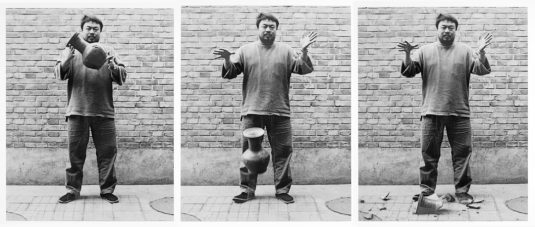
Ai, Rebel: The Art and Activism of Ai WeiweiAi, Rebel: The Art and Activism of Ai Weiwei
Seattle Art Museum, Seattle, WA - To Sep 7
During China’s Cultural Revolution, the poet Ai Qing was condemned as a bourgeois intellectual and exiled to Xinjiang, on the edge of the Gobi Desert. For his son, Ai Weiwei, art and activism became inextricably linked. For Ai, now a globally renowned artist, this exhibition marks his first US retrospective in over a decade, encompassing 40 years of provocative work in a progression of media. Ai’s early years as an artist in New York are documented in photographs, paintings and found-object assemblages influenced by Dadaism. In the mid-1990s, he returned to China in the midst of an economic boom. He collected the detritus of neighborhoods being razed in the rush to modernize, gathering everything from archaeological artifacts to building materials to abandoned bicycles. He deconstructed, copied and even destroyed them to create sculptures and installations that question what we value or discard, what is fake and what is cultural appropriation.
After the 2008 earthquake in Sichuan, Ai held the Chinese government responsible for inferior construction and the resulting casualties in works such as Snake Ceiling (2009) a 50-foot-long snake made up of children’s backpacks. As a result, Ai was arrested and imprisoned. The installation 81 (2013) recreates the cell where he was held for 81 days. In 2015, he moved to Berlin but remains vocal on issues from refugee rights to government surveillance. He illustrates these concerns in videos and in images constructed of LEGO. Ai adopted the plastic bricks as an egalitarian material, creating visual effects that reference mosaics, Pointillism and digital pixelation.
“Ai Weiwei is a global icon for his commitment to artistic freedom and the relentless pursuit of the truth,” says exhibition curator Foong Ping. “This historical moment calls for such an artist.”
Ai Weiwei: Water Lilies, a life-size reinterpretation in LEGO of one of Monet’s water lily paintings, is on display at the Seattle Asian Art Museum to March 15, 2026. Ai Weiwei: Circle of Animals / Zodiac Heads (Bronze), 12 bronze sculptures representing the symbols of the Chinese zodiac, will be installed at SAM’s Olympic Sculpture Park from May 17 (to May 17, 2027). Ai Weiwei Handbook, written by Foong, will be released in May.

